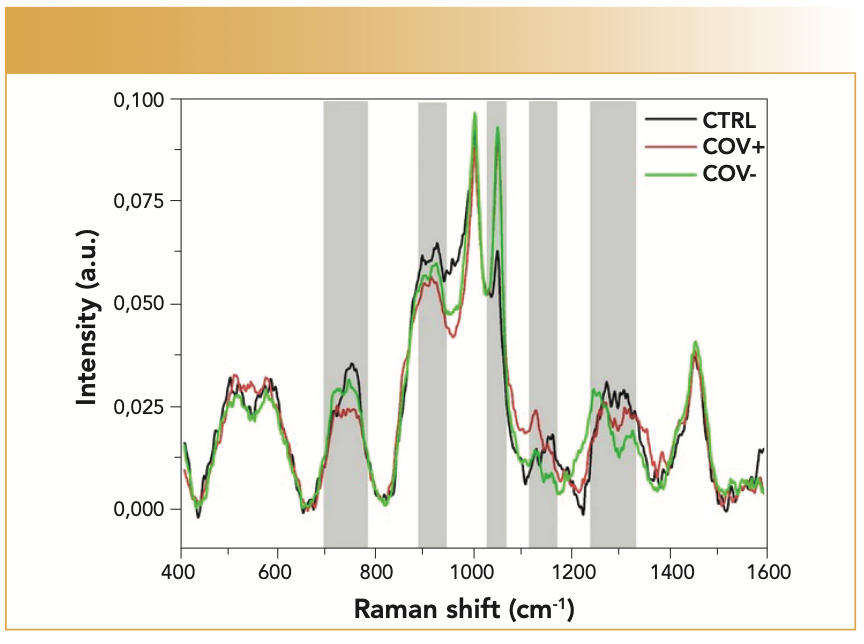Catching Covid: Rapid Spectroscopic Methods Show Promise
Since we have been beset by the global Covid-19 pandemic in early 2020, the scientific community has rallied mightily to produce both testing methods and vaccines. Over 1.5 billion Covid tests have been administered in just the United States, United Kingdom, and India alone. Both the common polymerase chain reaction (PCR) and the antigen tests rely on long-established technologies. Here, we explore how spectroscopy might play a part in next-generation Covid and pathogen testing.
It is hard to underestimate the global dislocations caused over the previous two years by the Covid-19 pandemic. Since its discovery during the initial outbreak in Wuhan, China, it has spread throughout the world, infecting more than 250 million people and causing more than 5 million global deaths. Thanks to the rapid response of the global scientific community, over 8 billion vaccine doses have been administered as of early December 2021.
Given its transmissibility, animal reservoirs, and the impossibility of vaccinating the entire human population, it seems highly likely that Covid-19 will become endemic. At the same time, current testing methods have substantial drawbacks. Although reverse transcription polymerase chain reaction (RT-PCR) tests are currently the gold standard for testing, there is a long period of incubation for Covid, and the RT-PCR test has a substantial false negative rate depending on the timing of the testing with respect to the peak infectiousness of an individual. As an example, a recent study published in The Lancet Microbe showed that in one super-spreader event, 36% of 148 infected close contacts tested with an RT-PCR test were initially missed (1), which coheres with the RT-PCR true positivity rates for nasal swabs of 63% observed in a study by Wang and others, where they also found higher true positivity rates (72%) for sputum samples (2).
This study suggests that other more rapid and accurate methods of testing may find traction in the coming years. Such methods should be easier to administer, such as the rapid antigen tests or lateral flow tests, and should also improve on the accuracy of the RT-PCR test. Substantial work is underway to apply optical methods that could meet these criteria. Efforts are concentrated in surface-enhanced Raman spectroscopy (SERS) and attenuated total reflection Fourier transform infrared spectroscopy (ATR-FT-IR). We briefly review progress of both methods in this article.
Surface-Enhanced Raman Spectroscopy (SERS)
In traditional Raman spectroscopy, the efficiency of the Raman effect is quite small; it is often cited that only one in a million of the incident photons scatters with a Raman shift, which creates quite a challenge for sensitive detection. In SERS, the presence of a localized surface plasmon on particular conducting surfaces, such as gold or silver nanoparticles, enhances the Raman effect. With SERS, Raman scattering intensity can be increased by a factor of 1010 or more, resulting in single-molecule detection.
Recently published results indicate that reagent-free SERS on saliva samples has promise. For example, a team of Italian researchers tested approximately 90 subjects that were divided as equally as possible between Covid-positive, Covid-negative, and control subjects. Saliva samples were collected and centrifuged (to remove food debris), then 3 μL of the saliva samples were deposited on a glass slide covered in commercially available aluminum foil to promote the SERS effect. A Horiba Raman microscope was used with a 785 nm laser to collect the SERS spectra. The averaged spectra from the control, Covid-positive, and Covid-negative subjects are shown in Figure 1. When spectra were analyzed using a multivariate chemometric model and a convolutional neural network, the method could distinguish between the three types of subjects with 84% sensitivity and could detect Covid-positive subjects 92% of the time (3). One disadvantage of this study was that it was conducted on an older population with a large number of patients who were critically ill and who, upon imaging, exhibited symptoms of pneumonia.
FIGURE 1: Differences in control (black) Covid-positive (red), and Covid-negative (green) SERS spectra of saliva, from reference (3). Shared under Creative Commons Attribution 4.0 International License.

A follow-up study by a team of Canadian researchers took a wider cohort of the population. Their population sample size consisted of males and females between 10 and 61 years old who volunteered to donate samples at a Covid-19 testing clinic. This cohort included asymptomatic volunteers as well as volunteers with and without respiratory symptoms. Similar to the Italian study, the researchers used a Renishaw Raman microscope with the excitation set at 785 nm, and with similar sample preparation. The spectra were then fed through a machine learning pipeline for discrimination. This study could detect Covid-positive males with 79% sensitivity and 75% specificity, and Covid-positive females with 84% sensitivity and 64% specificity (4).
Both of these studies seem to indicate comparable or better performance than the gold-standard RT-PCR tests, possibly without the uncomfortable nasal swab as well. Numerous other research groups are working in this area—for example, Miguel José Yacamán’s group at Northern Arizona University and Andrea Tao’s group at University of California San Diego. Several companies are working on clinical trials and preclinical trials, including Botanisol Analytics from Phoenix, Arizona, in cooperation with Ocean Insight, and GreenTropism from Paris, France, in cooperation with Horiba France SAS. The combination of a lateral flow immunoassay (which has limited sensitivity) with SERS has been suggested as a modality to optimize rapid point-of-care Covid detection (5).
Attenuated Total Reflection Fourier Transform Infrared Spectroscopy (ATR-FT-IR)
Given the success of Raman spectroscopy methods for Covid- 19 detection, it is natural to think that FT-IR spectroscopy may also find success in determining an individual’s Covid status. Recently, Kitane and others (6) investigated this possibility, using RNA extracted from nasopharyngeal samples. In their study, Kitane and others took 3 μL of extract that was directly scanned with a Jasco 4600 ATR-FT-IR spectrometer using a single-reflection ATR. Spectra collected at 2 cm-1 resolution in the range of 600–4500 cm-1 are then processed using a variety of machine learning techniques. The authors note that none of the features in the spectra could be directly attributed to Covid status. A subset of carbon- and phosphorous-related features were used to separate positives and negatives.
The results of the study, conducted on 280 samples (100 Covid-positive, 180 Covid-negative) of mostly asymptomatic males and females between the ages of 11 and 67 years old indicate that ATR-FT-IR has an estimated 98% accuracy, 97% sensitivity, and 98% specificity. These statistics are similar to clustered regularly interspaced short palindromic repeats (CRISPR)-based statistics. The authors suggest that the total analysis time could be as little as 1 to 1.5 min. The limit of detection of 10 RNA copies per milliliter is also competitive with CRISPR and the low-end of RT-PCR detection limits.
Other Optical Methods
There are a number of other optical methods for Covid detection that are not potentially as fast as SERS and ATR-FT-IR, but may be useful because of their specificity. For example, a tagged aptamer (short single-strand RNA or DNA sequence) can bind to specific proteins, such as the spike protein on Covid-19. The aptamer can then be detected using a number of methods, such as bilayer interferometry, plasmon resonance, or SERS (7). Similarly, particular nanoparticles can be conjugated to Covid-19 antibodies. Optical detection of the particles once they have attached to the Covid virus is then possible. Likewise, fluorescence of probe molecules or tip-enhanced Raman spectroscopy (TERS) have shown high specificity and low detection limits. Unfortunately, none of these methods have been made rapid enough to potentially qualify as a point-of-care diagnostics, as sample preparation and measurement times are typically measured in hours.
Conclusions
Both SERS and ATR-FT-IR have substantial potential as next-generation Covid-19 detection methods. Key attributes include high accuracy, sensitivity, and specificity, combined with speed and ease of use. As the Covid-19 virus becomes increasingly endemic, we should hope that our Covid-19 testing methods become both less intrusive and more accurate. Collecting saliva samples is much easier and more comfortable than nasal swabbing, for example. Even the RT-PCR gold standard has a non-negligible error rate at present.
If these optical methods provide the speed and accuracy in the field that has been shown in the laboratory, expect to see rapid adoption of SERS and ATR-FT-IR Covid test protocols in point-of-care situations as favorable clinical trial data are released. Furthermore, the machine learning algorithms employed will continue to evolve and improve with additional testing data, and the possibility exists to detect new Covid variants as well. Efforts within the photonics community toward Covid detection are well-placed, and the evolution of these methods over a short amount of time represents a great achievement!
References
(1) Z. Zhang, et al., The Lancet Microbe 2(2), e79–e87 (2021).
(2) W. Wang, et al., JAMA 323(18), 1843–1844 (2021).
(3) C. Carlomagno, et al., Sci. Rep. 11, 4943 (2021). https://doi.org/10.1038/s41598-021-84565-3
(4) K. Ember, et al., medRxiv, preprint. https://doi.org/10.1101/2021.09.21.21262619
(5) S. Yadav, et al., ACS Appl. Bio Mater. 4(4), 2974–2995 (2021). doi:https://doi.org/10.1021/acsabm.1c00102
(6) D.L. Kitane, et al., Sci. Rep. 11, 16740 (2021). https://doi.org/10.1038/s41598-021-95568-5.
(7) T. Stanborough, et al., ACS Omega 6(9), 6404–6413 (2021). https://doi.org/10.1021/acsomega.1c00008.
Steven G. Buckley, PhD, is the General Manager of the Applied Systems business at Ocean Insight, an affiliate associate professor at the University of Washington, and has started and advised numerous companies in spectroscopy and in applications of machine learning. He has approximately 40 peer-reviewed publications and 6 patents. His work in practical optical spectroscopy, such as LIBS, Raman, and TDL spectroscopy, dovetails with the coverage in this column, which reviews methods (new and old) in laser-based spectroscopy and optical sensing. Direct correspondence to: SpectroscopyEdit@mmhgroup.com.●


AI-Powered SERS Spectroscopy Breakthrough Boosts Safety of Medicinal Food Products
April 16th 2025A new deep learning-enhanced spectroscopic platform—SERSome—developed by researchers in China and Finland, identifies medicinal and edible homologs (MEHs) with 98% accuracy. This innovation could revolutionize safety and quality control in the growing MEH market.
New Raman Spectroscopy Method Enhances Real-Time Monitoring Across Fermentation Processes
April 15th 2025Researchers at Delft University of Technology have developed a novel method using single compound spectra to enhance the transferability and accuracy of Raman spectroscopy models for real-time fermentation monitoring.